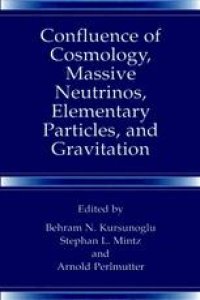
Ebook: Confluence of Cosmology, Massive Neutrinos, Elementary Particles, and Gravitation
- Tags: Nuclear Physics Heavy Ions Hadrons, Relativity and Cosmology, Mathematical and Computational Physics, Atoms Molecules Clusters and Plasmas, Elementary Particles Quantum Field Theory
- Year: 2002
- Publisher: Springer US
- Edition: 1
- Language: English
- pdf
Justbefore the preliminary programof Orbis Scientiae 1998 went to press the news in physics was suddenly dominated by the discovery that neutrinos are, after all, massive particles. This was predicted by some physicists including Dr. Behram Kusunoglu, who had apaper published on this subject in 1976 in the Physical Review. Massive neutrinos do not necessarily simplify the physics of elementary particles but they do give elementary particle physics a new direction. If the dark matter content ofthe universe turns out to consist ofneutrinos, the fact that they are massive should make an impact on cosmology. Some of the papers in this volume have attempted to provide answers to these questions. We have a long way to go before we find the real reasons for nature’s creation of neutrinos. Another neutrino-related event was the passing of their discoverer, Fredrick Reines: The trustees of the Global Foundation, members of the Orbis Scientiae 1998, dedicate this conference to Fredrick Reines of the University of California at Irvine. The late Professor Reines was a loyal and active member of these series of conferences on the frontiers of physics and cosmology since 1964. He also sewed as one of the trustees of the Global Foundation for the past three years. Professor Reines discovered the most elusive particle, the neutrino, in 1954. We are proud to say that we recognized the importance of this discovery by awarding him the J.
This conference was based on the discovery that neutrinos are massive objects, which gives elementary particle physics a new direction. This is the first in a series of conferences that will discuss the implications of this discovery and related issues, such as the impact on cosmology, proton spin content, strings, fractional spin and statistics, gravitation, and accelerated expansion of the universe.
This conference was based on the discovery that neutrinos are massive objects, which gives elementary particle physics a new direction. This is the first in a series of conferences that will discuss the implications of this discovery and related issues, such as the impact on cosmology, proton spin content, strings, fractional spin and statistics, gravitation, and accelerated expansion of the universe.
Content:
Front Matter....Pages i-xvi
On the Mass of the Neutrino....Pages 3-4
The Two Gravitating Massive Neutrino Pairs....Pages 5-23
The Current Status of LIGO....Pages 25-36
Solar Neutrinos: An Overview....Pages 37-52
Three-Neutrino Vacuum Oscillation Solutions to the Solar and Atmospheric Anomalies....Pages 53-61
Are There Four or More Neutrinos?....Pages 63-70
Neutrino Reactions in Nuclei and Neutrino Backgrounds....Pages 71-81
Is the Cosmological Constant Non-Zero?....Pages 85-93
Chern-Simons Violation of Lorentz and PTC Symmetries in Electrodynamics....Pages 95-100
Spin-Dependent Forces Between Quarks in Hadrons....Pages 101-109
Super Kamionkande Data on Proton Lifetime and Supergravity Models....Pages 111-120
Direct Detection of Dark Matter and Grand Unification....Pages 121-126
Breaking Lorentz Symmetry in Quantum Field Theory....Pages 127-132
Spin Structure with Lepton Beams....Pages 135-147
Spin and Statistics for Quantum Hall Quasi-Particles....Pages 149-161
Small Violations of Statistics....Pages 163-172
Quantized Membranes....Pages 173-194
Supersymmetric Wilson Loops and Super Non-Abelian Stokes Theorem....Pages 197-205
Back Matter....Pages 207-218
From Threebranes to Large N Gauge Theories....Pages 219-226
....Pages 245-246